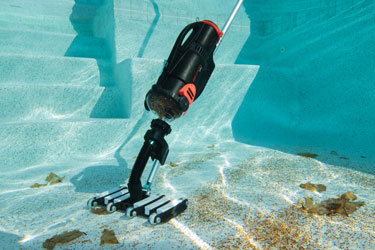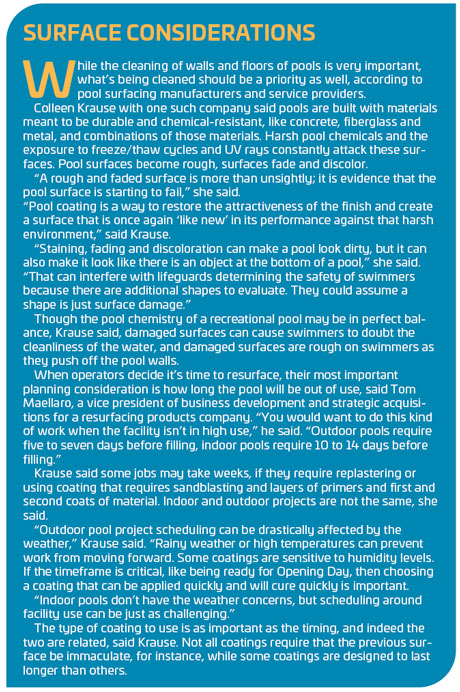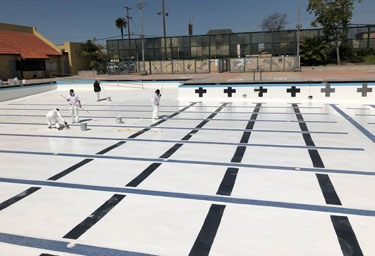Proper maintenance in aquatic facilities is vitally important to protecting the physical health of users and the financial health of the operators. The use and proper placement of drain covers as mandated by the Virginia Graeme Baker (VGB) Pool and Spa Safety Act of 2007 saves lives, while proper water chemistry helps prevent recreational water illnesses (RWIs) and keeps equipment healthy. When machines and systems are not serviced and full of water that’s not well-balanced chemically, they need to be expensively replaced. And any time the facility is shut down for equipment replacement or disease or resurfacing is revenue lost.
“Proper maintenance is vital to the health and safety of aquatic center patrons. Functioning filtration and chemical systems help to maintain water quality,” said Miklos Valdez, studio director of Counsilman-Hunsaker’s Aquatic Management Program. “Maintenance checks help to keep systems operating as they have been designed. When systems do not operate as they were designed, they can create hazardous situations for patrons.”
The right equipment plus training for staff to maintain it combined with proper water chemistry are foundations of strong maintenance programs, Valdez said. For example, properly installed and VGB-compliant drain covers help to reduce the potential for hair and body entrapment. However, for the covers to reduce the potential for incidents, they must be intact, in place and properly secured when the pool is open to the public.
“This means that someone, often maintenance teams, must verify prior to opening daily that all covers are intact and

properly secured to the sump via the hardware provided,” Valdez said. “This is also a VGB requirement.”
Valdez said all facilities should have maintenance plans that are compliant with the current Model Aquatic Health Code (MAHC) and facility-specific maintenance manuals that describe the daily processes required to maintain healthy water quality, safely and effectively handle chemicals, and implement preventive maintenance procedures.
Training of maintenance teams with pool operator training courses is crucial, Valdez said. These services give maintenance teams the information necessary to properly operate their aquatic centers according to industry standards and local protocols.
A large part of maintaining aquatic centers is also ensuring that they are being operated as safely as possible. This includes training on: chemical testing; documentation; fecal incident remediation; chemical dosing; water quality standards; safety standards; regular safety inspections; and regular maintenance inspections.
Valdez said the best staff maintenance training ensures all pool operators and maintenance staff have a current certification from a pool operator training course and that operators create training programs for team members as well as trainers to conduct maintenance inspections and safety checks. Each facility should have a comprehensive preventive maintenance manual and accountability policies to make sure it is followed.
One of the most important developments in the past decade to help operators maintain their facilities has not been in equipment or chemicals or philosophies, said Valdez. “I think the significant ways maintenance has changed over the past decade has really been the advancements in work order documentation and the communication systems we now have compared to 10 years ago,” he said. “There are now many programs and apps to assist operators with maintaining their facilities. The Model Aquatic Health Code has specific information on what to include with preventive maintenance programs. Ten years ago, many more operators didn’t know where to begin to create a preventive maintenance program.
“My hope is that we continue to elevate training programs to make better pool operators and inspectors.”

Richard Lindhorn is a marketing executive with a company that provides just such technology to smooth maintenance workloads for facility managers. The product addresses several key challenges, including the necessity for compliance in the regulation of commercial pools, spas and water features, labor shortages, and the imperative to maintain open pools with high-quality water to preserve revenue and customer satisfaction.
The technology for water safety automation and monitoring grants constant access, all year, to water quality data and analytics, enabling prompt decision-making to address any issues. Lindhorn also said his company’s procurement teams are ready to assist in sourcing elusive parts and equipment. “Furthermore, we offer programs such as property and portfolio compliance, providing assurance that a property adheres to all regulations through assessments and insights.”
The oversight of maintenance scales to any size operation from single facility to trends and analytics for corporate and regional multiples, Lindhorn said. “Our cutting-edge technologies are designed for universal adoption, catering to a diverse range of operators, managers and facility owners. Crafted by water and aquatics experts, our solutions empower frontline team members to efficiently manage and streamline daily tasks. This newfound efficiency allows them to redirect their time toward optimizing other areas of responsibility.”
Lindhorn said the efficiency, organization and analytics pays for itself in several ways, such as cost savings in water, electricity and gas through leak detection and operator improvements and reduction of electricity expenses through energy audits and assessments, leading to rebates and the adoption of higher-efficiency equipment.
For water conservation, the technology solutions play a crucial role, Lindhorn said. “The water safety automation and monitoring system enables real-time tracking of water quality issues, empowering quick responses to fix problems before they escalate, avoiding the need for extensive remediation,” he said. “By maintaining water balance consistently, unnecessary water waste through excessive backwashing of filtration or constant refilling is prevented, resulting in substantial water savings. Additionally, our leak detection and sustainability solutions use advanced technology to identify potential leaks promptly, allowing for swift resolution and further reducing water consumption.”
Gas cost management comes from a focus on mitigating leaks and optimizing water use, he said. “Recognizing the correlation between water loss and the need for additional gas to heat the pool, our solutions provide a comprehensive approach to address both aspects, contributing to overall efficiency and cost-effectiveness,” said Lindhorn.
correlation between water loss and the need for additional gas to heat the pool, our solutions provide a comprehensive approach to address both aspects, contributing to overall efficiency and cost-effectiveness,” said Lindhorn.
According to Lindhorn, the savings translates to return on investment numbers such as: an average of 15% to 20% savings in water usage, a 20% to 30% extension in equipment life, a 15% to 30% reduction in labor costs, and up to a 20% decrease in energy usage.
Another executive with a company that provides water filtration and disinfection systems believes the effects of technology on maintenance will only increase and evolve. “I believe we will see more predictive, AI-based maintenance assistant programs or offerings in the near future,” said Neal Hershey. “Sensor-collected data will automatically be used to drive maintenance decisions, and this information will also help manufacturers adjust their approach to maintenance recommendations. Soon, most pool facility maintenance will likely become more automated, and AI-assisted robotics may play a role in many aspects of pool maintenance operations.”
Kim Sherwood’s company manages commercial facilities by providing supervision, training, service, certified pool operators, and chemicals and supplies. Its commercial services can include facility evaluations, safety inspections for pools, development and implementation of operational and maintenance procedures, employee manuals, emergency plans and intensive training programs. Sherwood said aquatic facility maintenance has advanced mechanically and digitally, making life easier for operators and their employees. “The industry has advanced exponentially with automated systems that can control your chemicals and the use of Wi-fi for monitoring the pool when you are not there,” Sherwood said.
“Technologies like salt systems for generating your own chlorine can save money in the long run. Automatic vacuums have become a regularity for commercial pools as their technology has also gotten better. Facilities can also save more money because staff does not have to spend as much time with tasks like vacuuming the pool and monitoring the pool when not on site.”
The president of one company that makes state-of-the-art pool vacuums said one of the most important aspects of
today’s vacuum technology is that it’s widely available, which has brought down the price to be affordable for the majority of facilities. “The innovations in battery-operated, cordless pool vacs and robotic pool cleaners make it easy and fast for staff to keep pool surfaces free of debris as well as algae and other organic and inorganic byproducts that can be both unsightly and unhealthy,” said Guy Erlich. “In the past, many of these technologies were out of the price range of some aquatic facilities. But today’s new technologies are available from a wide range of suppliers with offerings for just about every budget.”

A vacuum helps in more ways than mere aesthetics, Erlich said. While a clean pool bottom surface is pleasing to the eye, it also means the pool is mostly free of debris that can erode particles into the water, clouding it and potentially harming the filtration system. Pool water that is filled with debris can be hazardous to patrons who may swallow the water or slip on debris on pool surfaces, and the harm that might come to patrons can be costly to facilities. In addition, debris that accumulates on pool surfaces can stain the pool finish which can cause deterioration of the surface and require draining of the pool water to treat the stained surfaces or to resurface the pool surface.
Regular, continuous cleaning of the pool can help facilities avoid expensive repairs and avoid having to close the pool, which can lead to lost revenues during repairs and remediation, said Erlich.
Handheld and robotic vacuums cover both spot-cleaning as well as thorough overnight treatment of the pool’s floor and walls, Erlich said. “Having a handheld, portable pool vacuum that is battery-operated makes it easy for staff to spot clean the pool floor throughout the day to avoid debris accumulation that could lead to clogging of filters, pool water quality or debris that could cause a patron to slip, ingest debris or cause bodily harm,” he said. “Robotic pool cleaners used in off hours can be programmed to clean the entire pool every evening. These robotic cleaners also help with pool water circulation, which help keep the pool filtration system from being overworked, especially during high bather loads in the pool.”
Erlich said that when operators shop for new vacuums, there are some features to look for. In the case of commercial
pools, cleaning of walls is generally a manual task performed by maintenance technicians, and the robotic cleaner is added simply to clean the bottom of the pool. With this in mind, look for a unit that can be changed from “floor/wall” to “floor only” mode at the touch of a button.
Sometimes commercial pools are so dirty they require more than one full cleaning. Therefore, a “time-delay” is another nice option to have, which allows the user to set the cleaner to start again three to five hours after it completes the first cleaning. This allows any dirt that has been lifted to settle on the pool floor to be picked up on the second pass.
A service light is another key feature for commercial pools, as this shows the operator when the unit needs maintenance. This not only ensures the cleaner operates correctly, but also that it functions to its full potential. Further, some robotic cleaners use an infrared obstacle detection system and can be operated via remote control, making them ideal for quick spot-cleaning. These cleaners also have a sensor for beach-entry pools and ramps, and can operate independently of the pool’s filtration system.

Good water quality is perhaps the most important goal of aquatic facility maintenance, as it affects nearly every potential hazard, from swimmer health to equipment functioning to cost savings. Valdez said maintaining proper chemistry in the water goes hand-in-hand with patron health and equipment maintenance.
Improper chemical balancing can create scale within piping and heating systems that may cause heating costs to increase, said Valdez. Additionally, scaling conditions or corrosive water conditions can destroy pool equipment including heaters, pumps and other equipment, which can be costly to replace.
Improper pool chemistry or hazardous situations may cause a local health department to shut down pools, leading to
significant revenue impacts, Valdez said. He said among the many worst-case scenarios of improper chemistry, off-gassing of chlorine due to the buildup of chemicals in circulation piping is particularly dangerous. “This can occur when interlock systems are not working, or are disconnected,” he said. “The MAHC requires monthly testing of interlock systems to help ensure that they are operating as designed.”
Also, ideal water quality maintenance can prevent outbreaks of recreational water illnesses (RWIs). Cryptosporidium is highly chlorine-resistant and can stay in pools for weeks at normal chlorine levels, said Valdez. “The best ways to protect pools are to make sure patrons and staff members are educated about staying out of the water for two weeks after diarrhea symptoms, to ensure they follow those protocols and when there is an incident, proper CDC-recommended remediation procedures must be followed.”
Pseudomonas aeruginosa outbreaks can occur in warm-water pools and hot tubs that have been insufficiently maintained, Valdez said. Often this can occur when facilities “usually” follow chemical residual guidelines and rules, but have days where little to no effective chlorine is measured, he said. Proper water chemistry can also prevent Legionnaires’ Disease outbreaks and amoeba infections.
Water quality and air quality are closely related as well, he said. “When combined chlorine, humidity and other environmental factors are not controlled through proper maintenance and inspections, they can cause issues with building systems including HVAC ductwork and other metal structures within the natatorium,” said Valdez.
Mike Fowler is a regional sales manager with an equipment company that strives for safe and clean water. He said the evolution of related technology has made it possible for the water in today’s facilities to be as safe as ever.

“With the advancement in chemical controller technologies, salt systems, UV systems, and the establishment of apps on your phone or computer to see what the chemical levels are in pools, there are so many ways to watch and check things in your pool and spa,” Fowler said. “A clean and well-balanced pool is a safe pool.”
Jeremy Stiles lives the importance of aquatic facility maintenance every day as senior association director of aquatics for YMCA of Greater Boston. There are 13 locations under his supervision, all with at least one pool.
“Aquatic safety starts with aquatic facility maintenance,” Stiles said.
Stiles said that just as lifeguards and swim instructors are always there to provide a safe and engaging experience for users, water quality and chemical levels need to be safe prior to opening the pools. This requires trained and certified staff to be constantly monitoring the equipment and chemicals, and to be inspecting pool decks and pump rooms on a routine basis. “Doing this allows the team to identify potential problems and address them before they occur, or to catch small problems before they turn into larger ones,” he said. “Often in the aquatics industry, pool maintenance is an afterthought, but we have worked hard to bring aquatic facility maintenance to the forefront of our training, policies, and procedures.
“Pools are like living and breathing entities, they need constant time, care and attention or they will get sick and lash out!”
Staff training is paramount, said Stiles—all YMCA Boston aquatic directors are required to be Certified Pool Operators through the Pool and Hot Tub Alliance, and facilities directors must have the same certification as backup and to support the aquatics department. All staff are provided a four-hour, in- person and hands-on training in each of the pump rooms that they are responsible for maintaining, Stiles said. There are also daily required inspections, checklists and tasks.
While Stiles is grateful for the systems alerts for chemistry and equipment his department enjoys, and recommends them highly, he said the advances in maintenance aren’t just technological. A 21st-century mindset has led the way. “Maintenance has changed significantly since I started as a CPO 15 years ago,” Stiles said. “Aquatic maintenance used to be what happened quietly and behind the scenes with personnel taking a reactive approach to pool maintenance as opposed to the proactive approach that we are starting to see more of today. Training used to be via word of mouth, handed down from person to person over the years with some tips and tricks, and the occasional bad habit or practice mixed in along the way.
“There was little requirement by code or standards for formal training and certification. Back then, technology wasn’t something you heard about in the aquatics space, and training and certification options were few and far between. The aquatic facility maintenance industry is growing rapidly, and formalizing with stricter rules and regulations, more trainings at a higher quality, and is beginning to be recognized as the important work that is needed to keep the public safe while continuing to provide access to swimming venues for both learning and leisure.” RM



